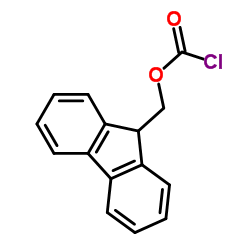Fluorenylmethoxycarbonyl Chloride
Nanjing Finechem Holdings Co., LTD
Synonyms
9-Fluorenylmethoxycarbonyl chloride
9-Fluorenylmethyl Chloroformate [N-Protecting Agent
9-fluorenylmethyl chlorocarbonate
9-Fluorenylmethyl Chloroformate Fmoc chloride
(9H-Fluoren-9-yl)methyl chloroformate
Fmoc-Cl
9H-fluoren-9-ylmethyl chloroformate
9-Fluorenylmethyl chloroformate
Fmoc chloroformate
Fmoc chloride
Product Description
Fluorenylmethoxycarbonyl chloride, also known as Fmoc-Cl, is a chemical compound that belongs to the
family of amino acid protecting groups. It is widely used as a reagent for the synthesis of peptides and
proteins, as it can be used to protect the amino group of an amino acid. Fmoc-Cl is a popular choice for
amino acid protection due to its stability and ease of use. In this article, we will explore the
production and application of Fmoc-Cl and its market industry development.
Production of Fmoc-Cl involves the reaction of fluorenylmethanol with phosgene, resulting in the
formation of Fmoc-Cl. The process is highly efficient and yields a high purity product. Fmoc-Cl is
commonly available in the form of a white to off-white crystalline powder with a purity of over 99%. It
is generally stored in a cool, dry place away from direct sunlight and moisture to maintain its
stability.
Fmoc-Cl has a wide range of applications in the field of peptide synthesis. It is used as a protecting
group for the amino group of an amino acid during peptide synthesis, which helps to prevent unwanted
reactions with other reagents. Fmoc-Cl is also used in the synthesis of peptides and proteins using
solid-phase peptide synthesis (SPPS) techniques. In addition, Fmoc-Cl is used in the production of
Fmoc-protected amino acids, which are widely used in peptide synthesis. These amino acids are crucial
building blocks in the production of peptide drugs and other biologically active compounds.
The market industry for Fmoc-Cl is expected to grow significantly in the coming years, driven by the
increasing demand for peptide and protein-based drugs. Peptides and proteins have gained significant
attention in the pharmaceutical industry due to their high specificity and efficacy. Fmoc-Cl is an
essential reagent in the production of these biologically active compounds. The rise in demand for
peptide and protein-based drugs is expected to drive the growth of the Fmoc-Cl market.
In addition, the increasing use of SPPS techniques in drug discovery and development is also expected to
drive the demand for Fmoc-Cl. SPPS techniques offer several advantages, such as high yields, low
production costs, and the ability to produce large quantities of peptides with high purity. The use of
Fmoc-Cl in SPPS techniques is expected to increase in the future, further driving the growth of the
Fmoc-Cl market.
In conclusion, Fmoc-Cl is a crucial reagent in the production of peptides and proteins, and its use is
expected to increase significantly in the coming years. The rise in demand for peptide and protein-based
drugs, coupled with the increasing use of SPPS techniques, is expected to drive the growth of the
Fmoc-Cl market.





